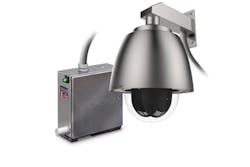Designing camera systems and housings to withstand extreme environments is nothing new for Moog. The company has been developing explosion-proof video surveillance products for the last 15 years; however, for the first time ever at this week’s ISC West show in Las Vegas, the company will be unveiling a first of its kind explosion-proof, high-definition camera system.
According to Christopher Lindenau, director of global sales and marketing, sensor and surveillance systems at Moog, the new EXO network camera system is the first solution designed by the company to meet Underwriters Laboratories’ standards for Class I and II, Division 1 hazardous environments.
“UL uses a division method when they’re classifying the risk associated with a hazardous environment. A hazardous environment could be an oil and gas facility, it could be a fertilizer plant, it could be petroleum refinement facility, the list goes on and on,” explained Lindenau. “Typically, people who have these environments or manage security for them, they know full well that they’re operating in a very hazardous environment, so these are the types of systems they search out.”
Although Moog has had a Class I, Division 2 product, Lindenau said that until now, they’ve had to turn away customers seeking a solution to meet the more stringent demands of UL’s Division 1 standard.
“Our previous generation product really could not be installed inside of these extremely hazardous regions within the facility. Those regions are typically classified where - either temporarily or permanently - there is a presence of explosive gases or combustible dust. Division 2 is everything outside of that. One thing holds constant and that is if you want to put a camera inside this area of high concern, i.e. the Division 1 area, you needed to have something that up until now wasn’t commercially available.”
One of the challenges that Moog’s engineers had in meeting the Division 1 requirements was creating a solution with fail safes that would immediately shut off the system in case there was a loss of pressurization inside the system.
“In a Division 2 environment, if you lose pressure inside the system, the system will send an alarm but other than that it doesn’t do a whole lot. It just tells you that you lost pressure and you need to get over there and inspect,” said Lindenau. “In a Division 1 environment, that thing better shut down, otherwise it could cause the whole area to blow up.”
According to Lindenau, one thing that separates the new EXO camera system from others on the market is that many competitive products are designed to meet the requirements of ATEX put forth by the European Commission and not necessarily the standards put forth in the UL Division 1 classification.
“ATEX has a different requirement from UL. I like to think of the UL requirement as more stringent and that is the division requirement. In the Division 1 requirement, we assume there is a constant explosive state, meaning at no time is there a mitigation of gaseous fumes,” he said. “We are designed, so that at all times, during normal operating conditions, you may have explosive fumes, vapors and combustible dust in the environment and have no concern.”
In addition to being the only HD explosion-proof camera on the market, according to Lindenau, he added that another differentiator between the EXO system and similar solutions is Moog’s “tried and true” protection method.
“Moog is, to our knowledge, the only manufacturer on the market using an approach called segregation. Segregation is what we achieve by keeping a constant flow of clean air inside the camera. We’re segregating, if you will, the air on the inside of that system from the explosive air on the outside,” explained Lindenau. “The other manufacturers use an approach called… the containment protection method. What that essentially says is that, ‘we don’t care whether it’s dirty inside the enclosure or dirty outside the enclosure, we’re going to put so much metal around this camera that even if it blows up, it’s not going to explode beyond the enclosure. In our approach, you’re not going to lose a camera.”
Lindenau said they hope to have production models of the new EXO camera ready to ship within three months.



